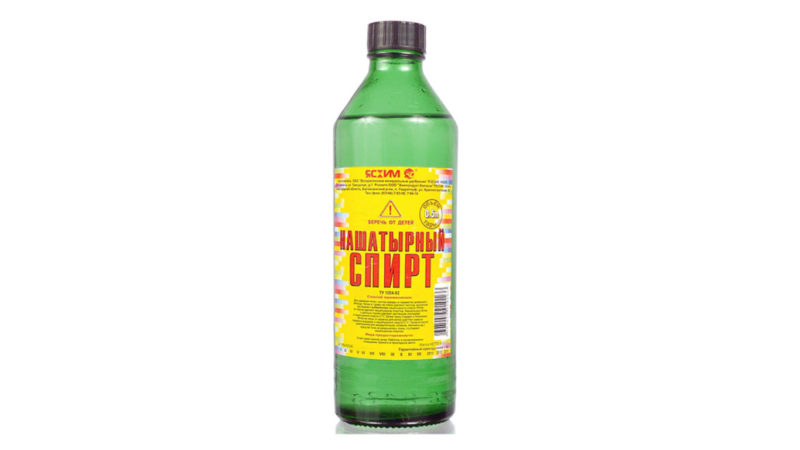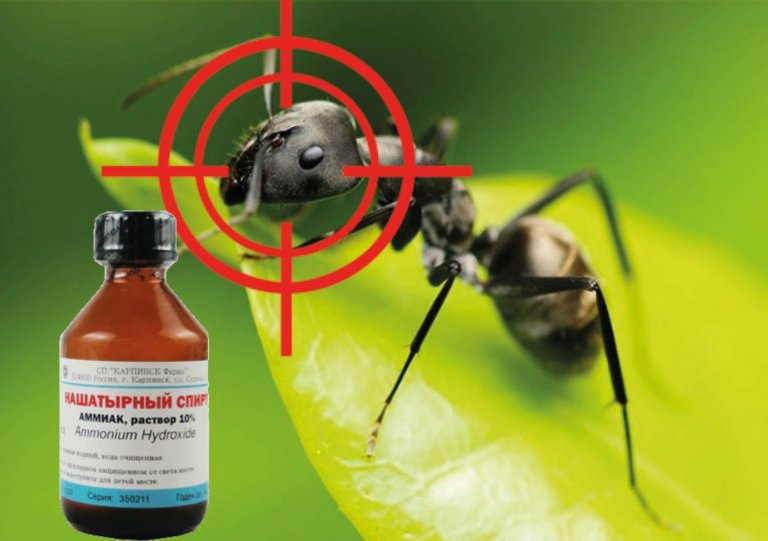Among the bright bags of seeds and fertilizers that have been purchased since the winter, there is definitely a place for small bottles bought with pharmacy names ammonia, ammonia. Ammonia gas, first obtained in 1774 under the name "alkaline air" near the ancient Libyan temple of Amun, has long taken the place of an indispensable assistant for curious summer residents. What secrets, possibilities and application does ammonia carry for plants as a top dressing, which has become a common element in caring for vegetables, trees, flowers?
Material Content:
Useful properties of ammonia
Important! The substance is a solution of ammonia in water. From the point of view of chemical terminology, the names ammonia, “ammonia” refer to another type of inorganic compounds of ammonium nitrate NH4Cl. In suburban areas it is not used.
The bottles purchased at the pharmacy are filled with a 10% solution called Ammonia, Ammonia.

The beneficial qualities of ammonia are determined not only by the high percentage of nitrogen (82%), vital for the development of any plants. The fact is that they absorb the main amount of nitrogen not from air, where the element content reaches 78%, but in bound form, from the soil.
The effect of the drug is beneficial in the following cases:
- Soil remediation. In poor areas, the beneficial effects of soil microorganisms are weakened. Their activity is activated by organic fertilizers. The process of their decomposition continues for several years. Financial, labor investments are required.The period of soil restoration is faster, does not affect the decline in yield, product quality when using ammonia.
- Plant nutrition with ammonia. The use of ammonia as a fertilizer for plants makes their development process quick and easy.
- Prevention of soil acidification. The solution is an alkali of medium strength. The need for frequent liming of the soil disappears. They make it with confirmation of the appeared acid reaction. After top dressing, nitrogen compounds do not accumulate in parts of the plant.
- Pest control.
The advantage of the substance is that it does not penetrate into the tissues of plants, accumulating in them, requiring time for decomposition. Do not forget to wash vegetables, fruits before eating are required for many reasons.
The signal for the use of ammonia is the following deviations in the development of plants:
- Thin, easily damaged stems with small leaves.
- The appearance of a yellow shade of leaves on the bottom row.
- Slowing growth, lack of flowers, falling ovaries.
- Negative reaction to frosts in trees, berries.
What plants can be fertilized with ammonia
The life cycle of any plant is associated with the process of building green mass, flowering, fruit formation. Nitrogen types of fertilizers help him make development effective. The need for nitrogen in all plants is different.
Among them there are big lovers of nitrogen, fertilizing with ammonia is most useful for them:
- Cabbage.
- Eggplant.
- Pumpkins, zucchini.
- Rhubarb.
- Peppers, potatoes.
- Perennial bulbous flowers.
- Peonies, dahlias, clematis.
- Raspberries, cherries, plums, strawberries, blackberries.
It is useful to feed any seedlings with an alcohol solution during the growth of the house, when transplanting to a permanent place.
Which plants do not use fertilizer from ammonia
Weak solutions are suitable for any plants, performing the function of fertilizers, for the purpose of prevention in the war against pests. For example, strawberries. The plant absorbs nitrogen from ammonia poorly. The use of ammonia in specific periods of growth is made taking into account the need of nitrogen for optimal development.

The average amount of plants required is:
- Cucumbers
- Tomatoes
- Beet.
- Garlic.
- Annual flowers.
- Corn.
- Bushes of gooseberries, currants.
- Apple trees.
Ways to work with ammonia
The solution is delivered to the plant by irrigation and spraying.
Important! The correct dosage will help prevent an excess set of green mass, lack of flowers, the accumulation of nitrates in tubers, and prevent the development of fungal diseases.

Due to the high volatility of the drug, it is recommended that spraying be done in bad weather with a watering can that forms noticeable splashes. A drizzle-like stream loses the bulk of the active substance in the air. Processing seedlings, indoor flowers is recommended to produce a weak stream directed under the root of the plants. The treatment of seedlings, indoor flowers is recommended to produce a weak stream directed under the root.
A toxic drug is effectively used for spraying from pests in the garden.
The following processing methods are recommended when they appear:
- Onion, carrot fly. A single row spacing is used with a solution of 5 ml of 25% ammonia in 10 l of water.
- Bear There is no reliable method for killing pests. Every year, all activities are repeated. The pest does not like pungent odors. As a prophylaxis, it is recommended to dilute 10 ml of alcohol in a bucket of water. In the hole, planned for planting seedlings, for example, cabbage, make 0.5 l of solution.
- Wireworm. Pest attacks root crops. Using them in food is not always possible. The larva of a nutcracker beetle, eating all kinds of plants, is neutralized with a solution of 10 ml of 25% ammonia in 10 l of water. The process is carried out during the planting of a tuber, nightshade plant.
- Aphids, ants. An effective prophylactic is considered to be a solution of 50 ml of alcohol, 25 ml of liquid soap in a bucket of water.You can spray plants in greenhouses weekly with a solution of 15 ml of alcohol in a bucket of water.
Weevil, Drosophila, onion cryptocephalus die after prophylactic treatment with ammonia.
Ammonia as a fertilizer

Experts recommend the following composition of solutions for feeding:
- Emergency watering is done with a solution of 1 large spoon of 25% ammonia per liter of water. This is the maximum allowable dose of the drug, which does not have a harmful effect on the plant.
- Flower, bulbous plants are recommended to be watered by dissolving 25 ml of alcohol in 10 l of water.
- Watering under the root of vegetables is done with a solution of three tablespoons of 25% alcohol in 10 liters of water.
- Spraying most garden crops produce a solution of 50 ml of the drug in 10 l of water.
- Processing seedlings, foliar dressing of flowers is recommended to be done with a solution of a teaspoon of ammonia in a liter of water.
Plant Nutrition with Ammonia
The soil in small summer cottages is often depleted, becoming less fertile. The effect of using ammonia to fertilize plants becomes immediately visible.
It is advantageous to do it for vegetables, berries, especially popular with owners of sites:
- Benefits for onions, garlic. A signal of a lack of nitrogen in plants is the appearance of yellow, drying feathers. Restore the growth of onion, garlic bushes will help feed the onion with a solution of 60 ml of alcohol in 10 liters of water. Do it in 6 days. To obtain a high-quality harvest of large onions, experts recommend starting in July with irrigation with a mild ammonia solution, consisting, for example, of a tablespoon of the drug per 10 liters of water.
- Fertilizing cucumbers with alcohol. It is carried out several times until the appearance of the fruit with a solution of a weak concentration of the drug. The solution is prepared using three large spoons of alcohol in a bucket of water. Watered under the root, if necessary, spray cucumber whips once a week.
- Ammonia for tomatoes. A good harvest is provided by a large number of strong fruits ripening on strong bushes. Growing a powerful bush helps fertilizing with a solution of low concentration, carried out every 10 days. The solution is watered wet after watering the soil under a bush of tomatoes.
Important! It is better to water more often, using a weak composition than strong ones to quickly destroy the plant.
Use of ammonia in the garden
To increase the growth of shrubs, trees, berries, for example, cherries, plums, raspberries, it is recommended to use solutions of various concentrations. This is determined by the strength of the plant's appearance. An effective feeding time is considered the period of the appearance of buds, flowers, the formation of fruit ovaries.

Flower beds respond well to the use of ammonia solutions.
The great benefit to the garden is due to the increased sensitivity of wasps, caterpillars, ants to the smell of low concentrations of ammonia used. To fix the solutions on the processed branches of the trees, the fatty acids that make up the soap are used. 30 ml of liquid soap, a spoonful of sugar are dissolved in 10 l of water. Spray the garden in calm, not rainy weather.
Precautions for use
Poisonous ammonia is easy to poison. Poison enters the body through the respiratory tract. Acts suddenly. Poisoning proceeds quickly, severely. All work with ammonia is carried out in a respirator, gloves, an apron, a plastic hat. Signs of poisoning are nausea, vomiting, burning. Before the urgent arrival of a doctor, it is recommended to drink a glass of warm milk. The likelihood of ammonia poisoning increases during operation in greenhouses. You can avoid poisoning by opening the windows, doors, lifting the film for air.












